Quantum Machine Learning: Where AI Meets Quantum Physics
26 July 2025
Quantum computing and artificial intelligence (AI) are two of the most innovative technologies of the 21st century. But what happens when these two cutting-edge fields collide? Enter Quantum Machine Learning (QML)—a fusion of quantum physics and machine learning that promises to revolutionize the way we process information. Curious about how this works? Well, you're in the right place!
In this article, we'll dive deep into the world of quantum machine learning. We’ll break down the basics, explore how it works, and discuss why this tech merger is a game-changer for the future. Ready? Let’s go!

What is Quantum Machine Learning?
Let’s start with the basics. Quantum Machine Learning (QML) is, as the name suggests, the intersection of quantum computing and machine learning. If you're familiar with machine learning, you already know that it's about teaching computers to learn from data. Think about how Netflix recommends shows based on your viewing history or how Google Photos recognizes faces. That's machine learning at work.Now, imagine if we could take the power of machine learning and supercharge it with quantum computing—a technology that uses the principles of quantum mechanics, like superposition and entanglement, to process information in ways traditional computers simply can't.
In essence, QML is like giving machine learning a rocket booster. But how exactly does quantum physics come into play? And why does it matter?

The Quantum Mechanics Behind It
Before diving into the "how," let’s briefly touch on some quantum mechanics concepts. I know, I know—quantum physics can seem intimidating, but bear with me, and I’ll simplify it.1. Superposition: In the quantum world, particles can exist in multiple states at once. Think of it like flipping a coin and it being both heads and tails at the same time. This allows quantum computers to process multiple possibilities simultaneously.
2. Entanglement: This is when two quantum particles become linked, and the state of one can instantly affect the state of the other, even if they're light years apart. It’s like a spooky connection between two particles!
3. Quantum Bits (Qubits): Regular computers use binary bits—either a 0 or a 1. Quantum computers, on the other hand, use qubits, which can be both 0 and 1 at the same time, thanks to superposition. This gives quantum computers the ability to perform multiple calculations simultaneously.
These principles are what give quantum computing its incredible potential. While classical computers solve problems step-by-step, quantum computers can tackle many computations at once. Now, imagine applying that to machine learning algorithms—the possibilities are endless!

How Does Quantum Machine Learning Work?
Alright, now that we’ve gotten the quantum basics down, let’s dive into the core of QML.In traditional machine learning, algorithms process data to make predictions or find patterns. This works great for simple tasks, but when the data becomes massive and complex (think huge datasets like climate models or genetic sequences), classical computers struggle to keep up.
This is where quantum computers come into the picture. Since qubits can handle multiple states at once, quantum computers can process huge datasets faster and more efficiently than classical computers. Quantum algorithms can explore multiple potential solutions at the same time, drastically reducing the time it takes to find the best one.
In QML, we combine quantum computing's speed and power with machine learning's algorithms. The result? Models that can learn and predict much faster than ever before.
Types of Quantum Machine Learning Algorithms
Just like traditional machine learning has different types of algorithms (like supervised learning, unsupervised learning, etc.), QML has its own set of quantum-enhanced algorithms. Here are some of the most important ones:1. Quantum Support Vector Machines (QSVMs): These are quantum-enhanced versions of support vector machines (SVMs), which are used for classification tasks. QSVMs can process more data points and higher-dimensional data more efficiently than classical SVMs.
2. Quantum Neural Networks (QNNs): Similar to artificial neural networks in classical machine learning, QNNs attempt to mimic the way the human brain works. Quantum neural networks can potentially solve problems in AI much faster due to the parallelism offered by qubits.
3. Quantum K-Means Clustering: Clustering is a method used to group data points. Quantum versions of clustering algorithms can handle larger datasets and find patterns faster than traditional clustering methods.
By utilizing quantum versions of these algorithms, we can expect to see machine learning models that are more accurate and can handle much more complex datasets than ever before.

Why Quantum Machine Learning Matters
Now that we’ve covered the ‘what’ and the ‘how,’ let’s talk about the ‘why.’ Why should we care about quantum machine learning? What makes it so important?1. Solving Complex Problems Faster
One of the most significant advantages of QML is its potential to solve problems that are currently unsolvable—or would take thousands of years for classical computers to solve. For example, pharmaceutical companies could use QML to simulate complex molecular interactions and discover new drugs much faster. Or climate scientists could use QML to model complex environmental systems and predict the impacts of climate change more accurately.2. Improving AI Accuracy
With QML, we can build more accurate machine learning models. Quantum computers can analyze and process more data simultaneously, which means they can better understand the nuances and patterns in the data. This can lead to more accurate predictions, better personalization (think smarter recommendation engines like Netflix or Spotify), and improved decision-making in AI applications.3. Enhanced Security
Quantum computing can also revolutionize cybersecurity. Quantum algorithms could potentially be used to develop more secure encryption methods. This is especially important in a world where data privacy is becoming increasingly crucial.4. Efficiency in Big Data Processing
As we generate more and more data every day, classical computers struggle to keep up. Quantum computing’s ability to process large datasets quickly could make it a game-changer for industries that rely heavily on big data, like finance, healthcare, and marketing. Imagine being able to analyze global financial markets or patient health records in seconds rather than days.Real-World Applications of Quantum Machine Learning
While QML is still in its early stages, there are already some exciting real-world applications being developed:1. Drug Discovery
Pharmaceutical companies are already exploring QML for drug discovery. Quantum computers can simulate molecular structures and predict how different molecules will interact with each other, potentially speeding up the development of new drugs.2. Optimization Problems
Many industries deal with optimization problems, whether it’s supply chain logistics, finance, or even public transportation systems. Quantum algorithms can solve these optimization problems much faster than classical ones, leading to more efficient operations.3. Natural Language Processing (NLP)
Quantum machine learning could enhance how AI understands and generates human language. This could lead to more advanced chatbots, better translation services, and improved voice recognition systems.4. Financial Modeling
In the finance world, quantum machine learning could help with portfolio optimization, risk analysis, and fraud detection, enabling financial institutions to make better investment decisions and protect themselves from fraud.
Challenges in Quantum Machine Learning
As promising as QML is, it's not without its challenges. Quantum computers are still in their infancy, and we’re a long way from having fully functional, large-scale quantum computers. Some of the major challenges include:- Error rates: Quantum computers are prone to errors due to the delicate nature of qubits. Stabilizing qubits and reducing errors is a significant hurdle.
- Scalability: Building quantum computers that can scale to solve real-world problems is another challenge. Most quantum computers today can only handle a small number of qubits.
- Algorithm development: We’re still in the early stages of developing quantum algorithms, and many of the machine learning techniques used today don’t have quantum equivalents yet.
But despite these challenges, the potential of QML is too great to ignore. As research in both quantum computing and machine learning continues to advance, we can expect to see more breakthroughs in the coming years.
Conclusion: The Future of Quantum Machine Learning
Quantum machine learning is where the worlds of AI and quantum mechanics intersect—and it’s a match made in tech heaven. By leveraging the power of quantum computing, we can build faster, more efficient machine learning models that can tackle even the most complex problems.While we’re still in the early stages of this technological revolution, the potential applications are vast. From drug discovery to financial modeling, QML promises to reshape industries and drive innovation in ways we’ve never seen before.
As quantum computers become more powerful and accessible, the possibilities for quantum machine learning will only continue to grow. So, if you’re someone who’s excited about the future of AI and quantum computing, keep an eye on this space—it’s going to be a wild ride!
all images in this post were generated using AI tools
Category:
Quantum ComputingAuthor:

Reese McQuillan
Discussion
rate this article
1 comments
Rayna McKnight
Incredible insights! Excited for the future of AI and quantum!
August 4, 2025 at 3:31 AM

Reese McQuillan
Thank you! I'm glad you found it insightful—exciting times ahead!


